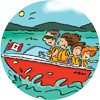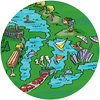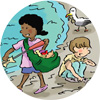|
 |
Water is a basic necessity of life, for people and for every type of plant and animal as well. Water is essential not only for survival but also for how it contributes to the quality of our lives. Water is used to produce power and to manufacture things. It provides transportation routes and many sources of recreation. It is essential for personal hygiene and helps flush away our waste products. Some people think it makes no difference how much water we use or how we use it. But it does. Water is a finite resource and most uses degrade its quality. There is no such thing as “new” water, so what we have today is our water future.
Not only do we need to worry about the amount of water we consume but also what gets into our sources of water that ends up causing pollution. Water pollution is a serious problem in our lakes, rivers and oceans. Most people think water pollution comes directly from a factory or other source that is recognizable. This is called "point source pollution." Today, the biggest source of pollution is us - you and me and what we do every day. This type of pollution is called "nonpoint source pollution" because it can't be traced to one single source. It's impossible to tell how much pollution is coming from where. Some examples of nonpoint pollution that ultimately end up in our waterways: used oil poured into storm drains; soil washed from construction sites; grease from restaurants and cafeterias poured down the drain; paint brushes cleaned in the street; unwanted chemicals poured in the ground; and fertilizer and pesticides washed off farm fields and city lawns. Sound familiar? That's why it is so important for all of us to clean up our act and learn how to prevent such pollution.
Where is water consumed at school? |
Washrooms/Gymnasium locker rooms: toilets, sinks, showers
Cafeteria: washing dishes, preparing food, drinking fountains
School Grounds: watering plants, irrigating lawns
|
Taking Action at School
|
 |
It's important to watch out for activities that might pollute the water and reduce water use whenever possible.
Some ideas for reducing water use or pollution at your school include:
· Install low flow faucet aerators and showerheads to reduce amount of water used.
· Conduct a water audit to determine where water is used in the school.
· Report water leaks to maintenance or janitorial staff immediately.
· Fix leaks in toilets, faucets, pipes immediately.
· Only run the dishwasher when it is full.
· Presoak dishes and utensils instead of running a water rinse.
· Collect rain water for irrigating or other non-potable uses.
· Ensure sprinklers are aimed at grassy areas of the school ground not the pavement when watering.
· Insulate hot water pipes.
· Purchase energy efficient dishwashers.
·Don’t “sweep” walks and decks with water. Use a broom or rake instead.
Helpful Water Web Sites
The following Web sites have interesting information and exciting opportunities to learn about water and how to protect our drinking water and keep our water sources clean.
Environment Canada’s Web site dedicated to water issues provides great information on Canada’s freshwater resources.
www.dfo-mpo.gc.ca/canwaterseauxcan/bbb-lgb/
Department of Fisheries and Ocean’s Big Blue Bus – Kid’s Corner has grown from an ocean's Web site to include all things water. Find out how to protect drinking water, how to keep water sources clean, how to adapt to climate change, what invasive species are and more. Teachers: check out The Library and The School House for ideas, resources and links.
www.dfo-mpo.gc.ca/canwaters-eauxcan/facts-faits/facts_e.asp
Department of Fisheries and Ocean’s Web site provides a wealth of great facts about Canada’s oceans and inland waters from the ocean floor to fish facts, from climate and pollution to tiny creatures and whales and dolphins.
Project Wet is a nonprofit water education program for educators and students located at Montana State University. Project Wet promotes awareness and stewardship of water resources through the development of classroom activities and teachers' aids.
 |
Ideas for Great Acts |
School Water Audit: students can conduct a water audit at the school to identify all uses of water throughout the school and develop an action plan to reduce the amount of water consumed in target areas.
Recipes for Clean Water: Students can investigate and test the effectiveness of traditional cleaning products compared to environmentally friendly, non-toxic recipes. http://www.wetcity.org/resources/RecipeForCleanWater.pdf
Build an Interactive Water Pollution Model: Environment Canada has developed an interactive pollution model that can be built by a class to explore the relationship between land activities and water pollution. http://www.pyr.ec.gc.ca/EN/IPM/
|
Games and Activities
|
 |
Earth Day Canada's environmental education program for youth features fun games and activities for kids and great resources and curriculum connections for educators.
www.on.ec.gc.ca/greatlakeskids/glk-home-e.html
The Great Lakes Kids Web site has games and jigsaw puzzles, quizzes and The Great Water Ride Adventure.
 |
Students Leading the Way -- Tell us what actions you're taking to protect water, the key to life. |
 |



